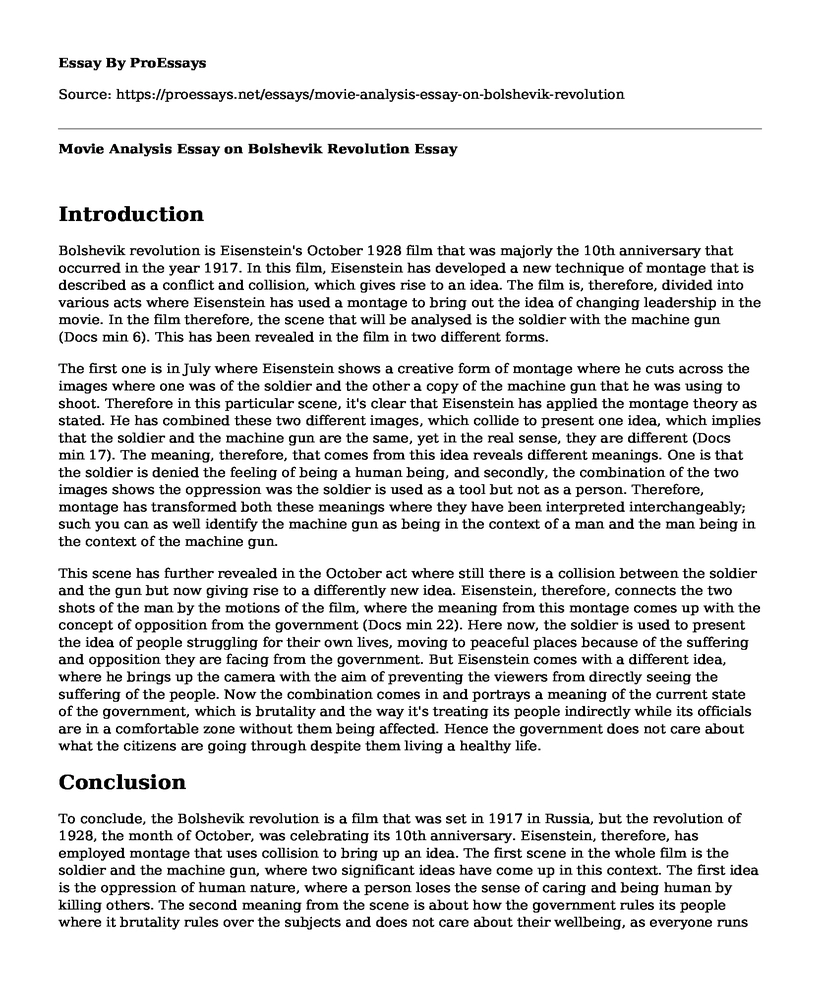Introduction
Bolshevik revolution is Eisenstein's October 1928 film that was majorly the 10th anniversary that occurred in the year 1917. In this film, Eisenstein has developed a new technique of montage that is described as a conflict and collision, which gives rise to an idea. The film is, therefore, divided into various acts where Eisenstein has used a montage to bring out the idea of changing leadership in the movie. In the film therefore, the scene that will be analysed is the soldier with the machine gun (Docs min 6). This has been revealed in the film in two different forms.
The first one is in July where Eisenstein shows a creative form of montage where he cuts across the images where one was of the soldier and the other a copy of the machine gun that he was using to shoot. Therefore in this particular scene, it's clear that Eisenstein has applied the montage theory as stated. He has combined these two different images, which collide to present one idea, which implies that the soldier and the machine gun are the same, yet in the real sense, they are different (Docs min 17). The meaning, therefore, that comes from this idea reveals different meanings. One is that the soldier is denied the feeling of being a human being, and secondly, the combination of the two images shows the oppression was the soldier is used as a tool but not as a person. Therefore, montage has transformed both these meanings where they have been interpreted interchangeably; such you can as well identify the machine gun as being in the context of a man and the man being in the context of the machine gun.
This scene has further revealed in the October act where still there is a collision between the soldier and the gun but now giving rise to a differently new idea. Eisenstein, therefore, connects the two shots of the man by the motions of the film, where the meaning from this montage comes up with the concept of opposition from the government (Docs min 22). Here now, the soldier is used to present the idea of people struggling for their own lives, moving to peaceful places because of the suffering and opposition they are facing from the government. But Eisenstein comes with a different idea, where he brings up the camera with the aim of preventing the viewers from directly seeing the suffering of the people. Now the combination comes in and portrays a meaning of the current state of the government, which is brutality and the way it's treating its people indirectly while its officials are in a comfortable zone without them being affected. Hence the government does not care about what the citizens are going through despite them living a healthy life.
Conclusion
To conclude, the Bolshevik revolution is a film that was set in 1917 in Russia, but the revolution of 1928, the month of October, was celebrating its 10th anniversary. Eisenstein, therefore, has employed montage that uses collision to bring up an idea. The first scene in the whole film is the soldier and the machine gun, where two significant ideas have come up in this context. The first idea is the oppression of human nature, where a person loses the sense of caring and being human by killing others. The second meaning from the scene is about how the government rules its people where it brutality rules over the subjects and does not care about their wellbeing, as everyone runs for his/her safety.
Works Cited
Docs Allthemed. October Ten Days that Shook the World. (1927). 2018. https://www.youtube.com/watch?v=adZ-QKyqyjM. Accessed on 20th October,2019
Cite this page
Movie Analysis Essay on Bolshevik Revolution. (2023, Feb 27). Retrieved from https://proessays.net/essays/movie-analysis-essay-on-bolshevik-revolution
If you are the original author of this essay and no longer wish to have it published on the ProEssays website, please click below to request its removal:
- Research Paper Example: American-Indians in World War II
- Answers and Questions About Rembrandt and Van Gogh
- Assignment Example on Ancient Egyptian Literature
- Song Analysis for "Another Brick in the Wall" by Pink Floyd
- essay sample on application of technologies in music
- Paper Example on Art and Photography
- Essay Example on Bebe: From 1976 to Reviving With Vibrant Designs







